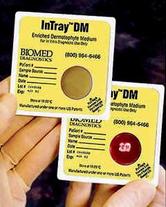Ringworm - A Fungal Skin Infection
|
Despite the name, ringworm is NOT a worm!! Ringworm is a skin disease caused by a fungus. The lesions that are created in the disease are often circular - hence the term "ring".
The technical name for ringworm is dermatophytosis. There are several species of fungal ringworm, but they all appear similar in symptoms. Be aware that ringworm should be diagnosed by your veterinarian- several skin diseases can look just like ringworm and will require different therapy. For example, mange mites, lick granulomas, bacterial infection, and atopy can all have similar symptoms to ringworm. Ringworm is potentially contagious to other pets and humans! Talk to your veterinarian promptly if your pet has skin disease. |
Symptoms of ringworm tend to appear 10 to 14 days after being exposed to the ringworm fungus. The fungus lives within hair follicles. As the ringworm invades and weakens the hair shafts, the hairs break off at the skin level causing patches of hair loss. These patches tend to be circular, but can also be irregularly shaped. The skin may also appear inflamed with scales or crusty debris. Some pets appear itchy while others do not. Pets may develop singular lesions or they can develop "generalized ringworm", which is seen in large patches all over the body. Cats are often asymptomatic carriers of ringworm (they have no skin lesions but can pass the infection on to others).
Young pets are most susceptible to developing ringworm, but any pet can be affected. Certain genetic lines may be more easily infected or if the pet's immune system is compromised.
Young pets are most susceptible to developing ringworm, but any pet can be affected. Certain genetic lines may be more easily infected or if the pet's immune system is compromised.
Ringworm can be transmitted by direct contact with infected pets or fungal spores in the environment. The ringworm fungal spores can cling to bedding, carpet, or in soil for several months. Ringworm can be passed from dogs to cats and vice versa. Children are most susceptible to ringworm; they can become infected from exposure to pets or other children. Adult humans are relatively resistant to infection unless they have a break in the skin or are immunocompromised. You should consult a physician if any family member develops skin lesions.
Ringworm is diagnosed using a variety of methods.
Ringworm is diagnosed using a variety of methods.
- Identification of a typical ringworm lesion (however, there are other skin diseases that may have a similar appearance).
- A Wood's lamp can be used to test for some forms of ringworm. Under a Wood's lamp, infected hairs and crusts will fluoresce or glow a bright apple green color. Not all types of the ringworm do this, so a negative Wood's lamp test does not officially rule out the possibility of ringworm.
- Culture of infected hairs is the true method for diagnosing ringworm (especially in cats that may appear asymptomatic). During this procedure, hairs are plucked from a skin lesion or a representative sample is brushed from the pet. These hairs are placed in a special gel which is then monitored for fungal growth and color change. Most ringworm cultures will turn positive within 10 days, but may take as long as 2 to 3 weeks.
Ringworm therapy takes many different forms depending on the pet and the severity of the lesions. The first step involves trying to decontaminate the pet's living environment. Dilute bleach (1 cup of bleach to 1 gallon of water) can be used in areas deemed appropriate to help kill fungal spores. Never apply bleach to your pet's lesions- you could severely injure your pet!! Be prepared that the treatment course is long no matter which method is chosen (usually several weeks at least). Immediate results will be hard to see- many pet's actually look worse before they start to look better. Infected pets can remain contagious for several weeks even with aggressive treatment, so these pets should be quarantined whenever possible.
Some long haired pets may need to be shaved. Total hair clipping used to be part of standard treatment, but this should only be done under certain circumstances and in a very controlled manner. Without proper sanitation, clipped hairs and contaminated grooming equipment can act as a means of disease transmission. Close clipping can also result in microscopic skin nicks which can encourage the spread of infection. Talk to your veterinarian before having your pet shaved or groomed.
Topical therapies are advisable for some pets- these may take the form of medicated dips or shampoos. Gloves should always be worn when handling infected pets for these procedures. Be prepared that some topical therapies may stain hair and clothing or have a bad odor (ex. lime sulfur dip). Severely affected animals may need oral anti-fungal medications. Pets on oral medications should be closely monitored for side effects (especially common in cats). Side effects may include: stomach upset, appetite loss, or diarrhea. Your veterinarian may also advise bloodwork while your pet is on these medications to look for internal side effects (especially liver problems).
Some long haired pets may need to be shaved. Total hair clipping used to be part of standard treatment, but this should only be done under certain circumstances and in a very controlled manner. Without proper sanitation, clipped hairs and contaminated grooming equipment can act as a means of disease transmission. Close clipping can also result in microscopic skin nicks which can encourage the spread of infection. Talk to your veterinarian before having your pet shaved or groomed.
Topical therapies are advisable for some pets- these may take the form of medicated dips or shampoos. Gloves should always be worn when handling infected pets for these procedures. Be prepared that some topical therapies may stain hair and clothing or have a bad odor (ex. lime sulfur dip). Severely affected animals may need oral anti-fungal medications. Pets on oral medications should be closely monitored for side effects (especially common in cats). Side effects may include: stomach upset, appetite loss, or diarrhea. Your veterinarian may also advise bloodwork while your pet is on these medications to look for internal side effects (especially liver problems).





